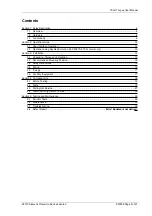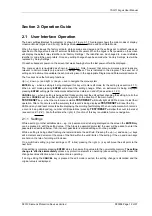
7SG11 Argus User Manual
©2013 Siemens Protection Devices Limited
P20006 Page 8 of 37
1.3.1.4 Voltage Protection
Certain Argus 2 models only.
A three-phase voltage element with definite time delay is provided which can be used to provide a trip or alarm
output, or can be set to block any of the overcurrent elements. The element can be set to undervoltage or
overvoltage with variable hysteresis. Overcurrent blocking occurs from each phase independently, but a common
trip output is provided.
1.3.1.5 Cold Load Pickup
Argus 4 and Argus 6 only.
The Argus can apply higher current settings with longer time delays, after the circuit breaker has been open for a
programmable time. On closing of the circuit breaker these higher settings are applied for a programmable time or
until the measured current has fallen to normal levels.
1.3.1.6 Circuit Breaker Fail
The circuit breaker fail function operates by monitoring the current following a trip signal and issues an alarm if the
current does not cease within a specified time interval. A two-stage time delayed output can be used to operate
output contacts to retrip the same circuit breaker, using a second trip coil, or to backtrip an upstream circuit
breaker.
The CBF timer 1 starts to operate following a trip output from any one of the protection algorithms or an external
input, providing there is current above the circuit breaker fail current setting. An output is issued after the CBF
timer 1 delay. If current is still above the setting, CBF timer 2 then begins to operate and will issue a second
output after the CBF timer 2 delay.
1.3.2 Control
1.3.2.1 Autoreclose
Argus 4 and Argus 6 only.
Integrated auto-reclose is available as an ordering option. The Argus incorporates a 5 trip/4 close auto-reclose
sequence that can be initiated by an internal or external signal. For each type of protection trip - phase-fault,
earth-fault, SEF or external - a separate sequence of instantaneous and delayed trips is available. Programmable
dead times and reclaim times with a wide setting range and integrated sequence co-ordination enable virtually all
distribution auto-reclose schemes to be achieved.
1.3.3 Plant Monitoring
1.3.3.1 Trip Circuit Supervision
An Argus relay can monitor its associated trip circuit by configuring one of its status inputs using the ‘Trip Circuit
Fail’ setting and connecting the input into the trip circuit (refer to the applications guide for details of how this is
achieved). Indication is then given instantaneously of ‘Trip Circuit Failure’ should a fault be detected, this display
also identifies which input has detected the fault. Since the status inputs can be programmed to operate output
contacts, an alarm output can also be generated from the trip circuit supervision feature.
1.3.3.2 Circuit Breaker Maintenance
The I
2
summation feature and the trip counter provide circuit breaker condition monitoring. Alarm outputs with
programmable settings are available for both features.
This information is accessed either from the front panel or via the communications interface. The values of
current used for the I
2
summation are those measured at the time of issuing a trip signal. An I
2
sum is generated
for each phase element and the highest value is used for alarm and display purposes. It is also possible to initiate
the I
2
summation algorithm from an external tripping device via the status input if required.
The trip count and the I
2
summation count can be reset by either of two methods:
when viewing the appropriate instrument screen and pressing the
TEST/RESET
button
in the settings menu using appropriate reset setting
1.3.4 Measurements
Analogue values can be displayed in primary or secondary quantities on the LCD screen. In addition the values
can be obtained via the communications port.
















































